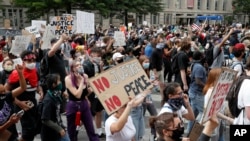The United States is the only Western nation among the world’s 50 most conflict-ridden countries, according to new research that measures political violence around the globe.
The U.S. ranking is driven by rising levels of political violence and a proliferation of far-right groups in the country in recent years, according to the Armed Conflict Location & Event Data Project, or ACLED.
ACLED, a data collection, analysis and crisis mapping nonprofit based in the U.S. state of Wisconsin, gathers data for more than 240 countries and territories around the world. In the 12 months to early September, it recorded more than 139,000 incidents of political violence worldwide, an increase of 27% over the prior year.
The ACLED Conflict Index ranks every country and territory according to four indicators — deadliness, danger to civilians, geographic diffusion and armed group fragmentation — using data collected for the past year.
While most countries saw at least one incident of political violence over the past year, 50 were ranked the highest in terms of their levels of conflict, receiving ratings of “extreme,” “high,” or “turbulent.”
Myanmar, with the highest number of armed groups in the world, topped the list with a rating of “extreme,” followed by Syria and Mexico.
The U.S. was rated as “turbulent,” along with 19 other countries, mostly in Africa and Asia, including Libya, Ghana and Chad.
Sam Jones, head of communications at ACLED, said the U.S. placement on the list shows that political violence is not confined to poor or nondemocratic countries.
“The U.S. is in the same turbulent index category as other countries that might be more traditionally understood as ‘conflict-affected’ like the Central African Republic … though, of course, it has a much lower overall ranking than such countries, which is important to note,” Jones said in an email to VOA.
Jones said a deterioration in two indicators — danger to civilians and armed group fragmentation — was largely responsible for the U.S. ranking.
“Danger to civilians” represents the number of violent incidents targeting civilians and includes acts of violence such as police shootings.
The “armed group fragmentation” indicator is equally important. It indicates the number of armed groups such as militias involved in political violence.
In the American context, it means that “non-state armed actors, such as far-right militia groups … have increasingly proliferated and splintered, which is correlated with higher risks of violence and creates additional obstacles for violence prevention efforts,” Jones said.
While the U.S. is the only Western nation in ACLED’s list of the top 50 conflict-ridden countries, it is not the only country in the West that has seen an increase in political violence and unrest.
France was wracked by violent anti-police riots this summer after police shot and killed a teenager in a Paris suburb.
Canada has seen a small but noticeable uptick in anti-LGBTQ demonstrations in recent years, a spillover from larger U.S. protests organized by far-right groups.
Thomas Zeitzoff, a political violence expert at the American University in Washington, noted that recent elections in both France and Canada have been marked by vitriolic rhetoric.
“It’s not the same level of violence [in France and Canada], but I think in general the U.S. is not isolated in that there is definitely … across the Western world … increased political contention,” Zeitzoff said.
Zeitzoff cautioned that the ACLED data might be subject to a “reporting bias” because the U.S. has a free press that reports on violence while many countries with high levels of violence have less press freedom.
“We have a pretty good idea when violence happens in the U.S., but we don't have a very good idea about when violence happens in rural Mexico or in northern Nigeria or in rural parts of Afghanistan,” Zeitzoff said in an interview.
Asked about this criticism, Jones said data collection in countries which restrict media is a challenge ACLED has tried to mitigate by relying on verified “new media” and its network of more than 60 partner organizations around the world.
“There are no perfect solutions — and we certainly don't purport to be perfect; our data represent estimates and we encourage users to take all of these caveats and methodological limitations into consideration when working with the data — but we are always trying to improve and account for any such challenges and potential biases as best we can,” Jones said.
ACLED has been tracking U.S. political violence since 2020, a year marked by a perfect storm of crises — a deadly pandemic, social justice protests and a divisive presidential election.
“Those three things made the U.S. really kind of explode in terms of demonstrations, but also political violence,” said ACLED President and CEO Clionadh Raleigh, who created ACLED as an academic project in 2005.
Whether the trend of rising conflict continues into the 2024 U.S. presidential election remains to be seen, Raleigh said during a Tuesday webinar on ACLED’s latest findings.
“But what we can say is that the U.S. has reached a level of demonstrations, including riots and potential mob violence, that it's managing to sustain rather than decrease from even in nonelection years,” Raleigh said.
“And that is, I think, unsettling quite a number of people because it's highly localized … and it has a lot [of] fuel to keep it going with the U.S. political system.”







